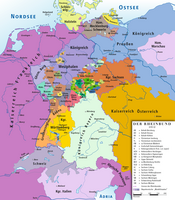Saxe-Weimar
Duchy of Saxe-Weimar Herzogtum Sachsen-Weimar | |||||||||
|---|---|---|---|---|---|---|---|---|---|
| 1572–1809 | |||||||||
 Saxe-Weimar, shown within the other Ernestine duchies and showing Saxe-Jena, which was joined to Saxe-Weimar in 1690 | |||||||||
| Status | State of the Holy Roman Empire, then State of the Confederation of the Rhine | ||||||||
| Capital | Weimar | ||||||||
| Government | Principality | ||||||||
| Historical era | Middle Ages | ||||||||
• Division of Erfurt | 1572 | ||||||||
| 1602 | |||||||||
| 1640 | |||||||||
| 1672 | |||||||||
• United with Saxe-Eisenach | 1741 | ||||||||
| 1809 1809 | |||||||||
| |||||||||
Saxe-Weimar (German: Sachsen-Weimar) was a duchy in Thuringia, Germany. The chief town and capital was Weimar.
History

In the 15th century much of what is now Thuringia, including the area around Weimar, was in the hands of the Wettin dynasty, the Electors of Saxony. In 1485 the Wettin lands were divided, with the lands in Thuringia going to the Ernestine branch of the family. The Ernestines also retained the title of Elector. When John Frederick the Magnanimous was defeated and captured by Holy Roman Emperor Charles V in 1547 and deprived of the electorate, he was allowed to retain the lands in Thuringia. In 1572 the Ernestine lands were divided by his sons into the duchies of Saxe-Weimar and Saxe-Gotha.
For the next three centuries the lands were divided when dukes had more than one son to provide for, and re-combined when dukes died without direct heirs, but all of the lands stayed in the Ernestine branch of the Wettin family. As a result, the Duchy of Saxe-Weimar shrank and grew more than once. The duchies of Thuringia throughout this period typically consisted of several non-contiguous parcels of territory of various sizes. In 1741 Duke Ernest Augustus I of Saxe-Weimar inheritated the Duchy of Saxe-Eisenach. Ernest Augustus II, who succeeded in 1748, died in 1758, and his young widow, Anna Amalia, was appointed regent of the country and guardian of her infant son, Charles Augustus. The regency of Anna Amalia and the reign of Charles Augustus formed a high point in the history of Saxe-Weimar. Both intelligent patrons of literature and art, Anna Amalia and Charles Augustus attracted to their court the leading scholars in Germany, including Goethe, Schiller and Herder, and made Weimar an important cultural center.
Charles Augustus joined Prussia in the War of the Third Coalition against France and after the loss to France in the Battle of Jena-Auerstedt, he was forced to join the Confederation of the Rhine in 1806. In 1809 Saxe-Weimar and Saxe-Eisenach, which had been united only in the person of the duke, were formally merged into the Duchy of Saxe-Weimar-Eisenach.
Dukes of Saxe-Weimar
- Johann Wilhelm (1554–73)
- Frederick Wilhelm I (1573–1602), son of Johann Wilhelm
- Johann (1602–05), son of Johann Wilhelm
- Johann Ernst I (1605–20), son of Johann
- Wilhelm (1620–62), son of Johann. Became first regent (1620) when Johann Ernst I was stripped of his title by Emperor Ferdinand II of Austria towards the beginning of the Thirty Years' War and assumed the dignities upon his death in 1626.
- Johann Ernst II (1662–83), son of Wilhelm
- Wilhelm Ernst (1683–1728), son of Johann Ernst II
- Johann Ernst III (1683–1707), son of Johann Ernst II
- Ernst August I (1707–48), son of Johann Ernst III
- Ernst August II (1748–58), son of Ernst August I
- Karl August (1758–1809), son of Ernst August II
Merged with Saxe-Eisenach to form Saxe-Weimar-Eisenach
See also
References
- This article incorporates text from a publication now in the public domain: Chisholm, Hugh, ed. (1911). Encyclopædia Britannica (11th ed.). Cambridge University Press.
{{cite encyclopedia}}: Missing or empty|title=(help) - Saxe-Weimar, The Columbia Electronic Encyclopedia, Sixth Edition, Columbia University Press (2001–2005), accessed December 22 2005
External links



